MD Murshedul Hoque
Chief Bridge Engineer
How to choose a perfect SDLC (Waterfall, Agile, Kanban and Scrum)
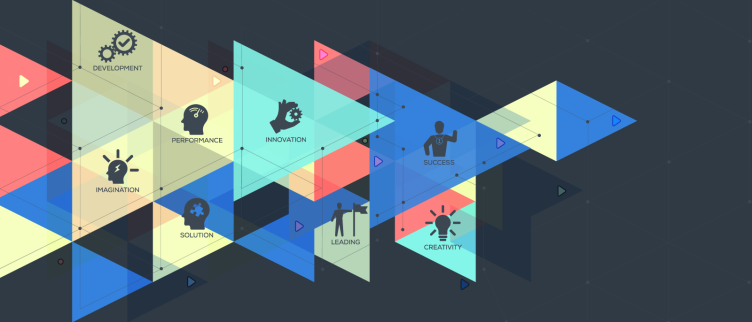
If not sure which project management methodology(SDLC) or framework will be the best to manage the team; Learn everything about waterfall, Agile, Kanban, and Scrum—what they stand for, how to use them, the benefits and drawbacks, and how they compare to one another.
What is the waterfall?
The waterfall model divides each project into different phases and moves through the phases in sequential order. No phase can begin until the phase before it is completed.
The specific phases of the waterfall process typically look similar to this:
- The requirements phase, sometimes split into an additional analysis phase.
- System design phase.
- Implementation phase, also known as the development phase or coding phase—depending on the type of project.
- Testing phase.
- The deployment phase, also known as the operations phase.
- Maintenance phase.
How the waterfall works

The phases of the projects look like they’re cascading from one phase to the next.
Implementing this project management methodology requires a lot of up-front planning and preparation.
And the major part of this methodology is creating an airtight project plan so your team clearly understands the project requirements and restraints before they get started on the work.
This project methodology is great for time management and progress tracking, though it’s less flexible than other models.
Pros of waterfall
Waterfall project management is more effective for cross-functional projects. Some of the biggest advantages of the waterfall methodology are that you can…
- Plan projects ahead of time to prevent scope creep.
- Track progress easily between different phases of the project.
- Work on multiple projects without being completely dedicated to one initiative.
- Manage dependencies with ease.
Cons of waterfall
However, the waterfall methodology also comes with a few disadvantages that are important to note:
- Can lead to increased project risk due to lack of flexibility.
- Can lead to loss of information if different people work on the project during different phases and don’t document clearly.
- Can lead to unexpected bugs when QAs happen late.
- Can cause decreased customer satisfaction without their involvement.
What is Agile?
Agile project management is an iterative methodology where work is completed in short sprints. By prioritizing a flexible approach and continuous delivery, the Agile method is more flexible when it comes to unexpected project changes—however, it can suffer from scope creep as a result.
How Agile works
Agile project management includes iterative backlog management, sprints, reflection, iteration, and more sprints. Each Agile sprint typically lasts two to four weeks.

Each sprint goes through the following phases:
- First, the product owner organizes the product backlog. The product backlog is a list of every task that may be worked on during the sprint. This information is usually stored in a project management tool.
- Before the sprint, the entire project team participates in sprint planning to identify the best tasks to work on during the two-week period.
- During the sprint, Agile teams meet frequently to discuss blockers and action items.
- Once the sprint is over, team members get together to run a sprint retrospective and identify what went well and what could have been better.
Pros of Agile
The Agile methodology is popular for a reason—here are some of the biggest advantages for Agile teams. They…
- Adapt quickly to unexpected changes.
- Focus on customer satisfaction.
- Experience high intrinsic motivation by emphasizing teamwork and team member involvement.
Cons of Agile
With all of that flexibility come a few disadvantages Agile teams have to face:
- Can increase scope creep and project budget unexpectedly.
- Can be difficult to engage with customers if they don’t have the time or bandwidth.
- Focusing exclusively on the Agile sprint process doesn’t allow team members to work on other initiatives.
- Can be difficult for virtual teams to thrive in Agile environments.
What is Kanban?
Kanban is a subsect of the Agile methodology and functions within the broader Agile mentality. The Agile philosophy is all about adaptive planning, early delivery, and continuous improvement—all of which Kanban can support.
When speaking of Kanban in project management, most commonly refer to Kanban boards. A Kanban board represents stages of work with columns that hold the individual tasks for each stage—but more on that in a little bit.
How Kanban works
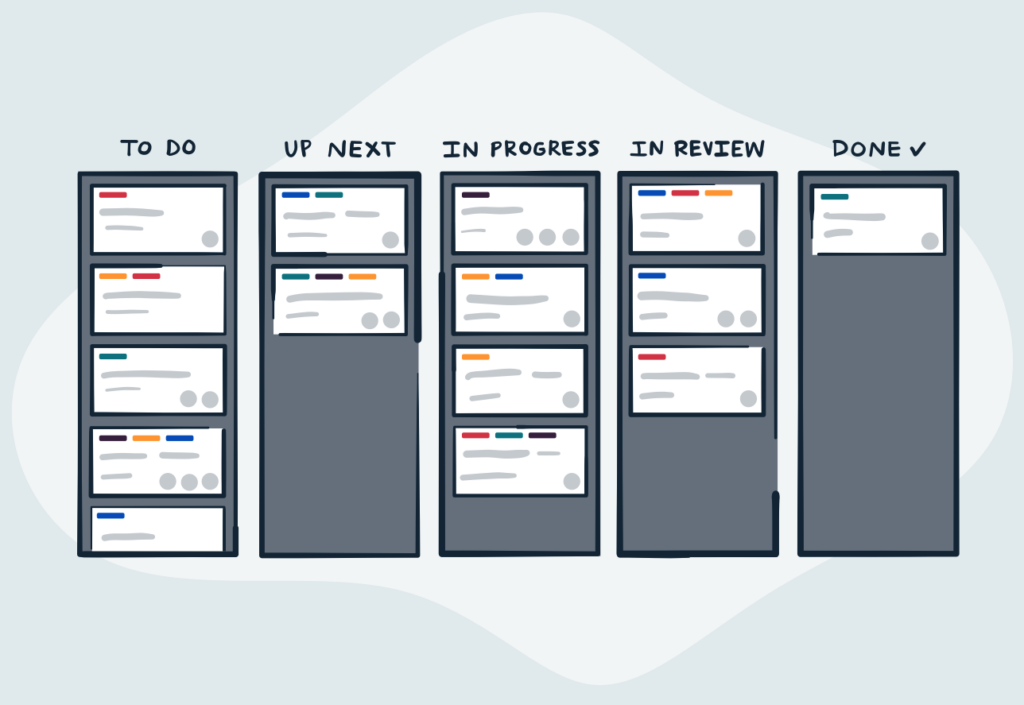
Benefits of Kanban boards
- Tasks or deliverables.
- Task assignee.
- Due dates
- Task details
- Context
- Relevant files
- Relevant tags, like priority or task type
The modern Kanban framework is an online, visual method to manage work. Typically these stages are ‘to do’, ‘in progress’ and ‘done’.
Kanban boards are one of the most popular forms of visual project management. They’re most effective for providing easy, at-a-glance insight into a project.
What is Scrum?
Scrum is an Agile Project Management Framework that helps team structure and manage their work through a set of values, principles, particles, guidelines and roles to help a team focus on continuous improvement and iteration.
It’s much less flexible than Kanban but a great way for Agile teams to collaborate and get high-impact work done.
How Scrum works
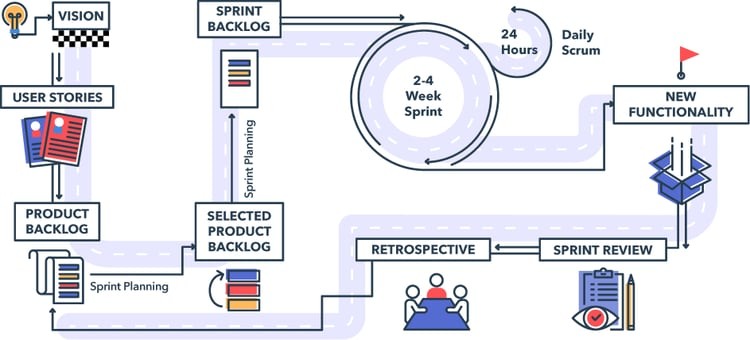
While Scrum, like Agile, was originally created for software development teams, industries like product, engineering, and others now run Scrum to execute their work faster and more effectively.
To run a Scrum, teams typically assign a Scrum master, who is in charge of running the three distinct Scrum phases and keeping everyone on track. The Scrum master can be your team lead, project manager, product owner, or the person most interested in running Scrum.
The Scrum master is responsible for implementing the three traditional Scrum phases:
Phase 1: Sprint planning. A Scrum sprint is usually two weeks long, though teams can run faster or shorter sprints. During the sprint planning phase, the Scrum master and team take a look at the team’s product backlog and select work to accomplish during the sprint.
Phase 2: Daily Scrum standups. Over the course of the Scrum teams traditionally meet for 15 minutes every day to check in on progress and make sure the amount of assigned work is appropriate.
Phase 3: Sprint retrospective. When the Scrum is over, the Scrum master hosts a sprint retrospective meeting to evaluate what work was done, route any unfinished work back into the backlog, and prepare for the next sprint.
The goal of Scrum isn’t to build something in two weeks, ship it, and never see it again. Rather, Scrum embraces a mindset of “continuous improvement,” where teams take small steps towards bigger goals. By breaking work into smaller chunks and working on those chunks, Scrum helps teams better prioritize and ship work more efficiently.
How to choose the right project methodology
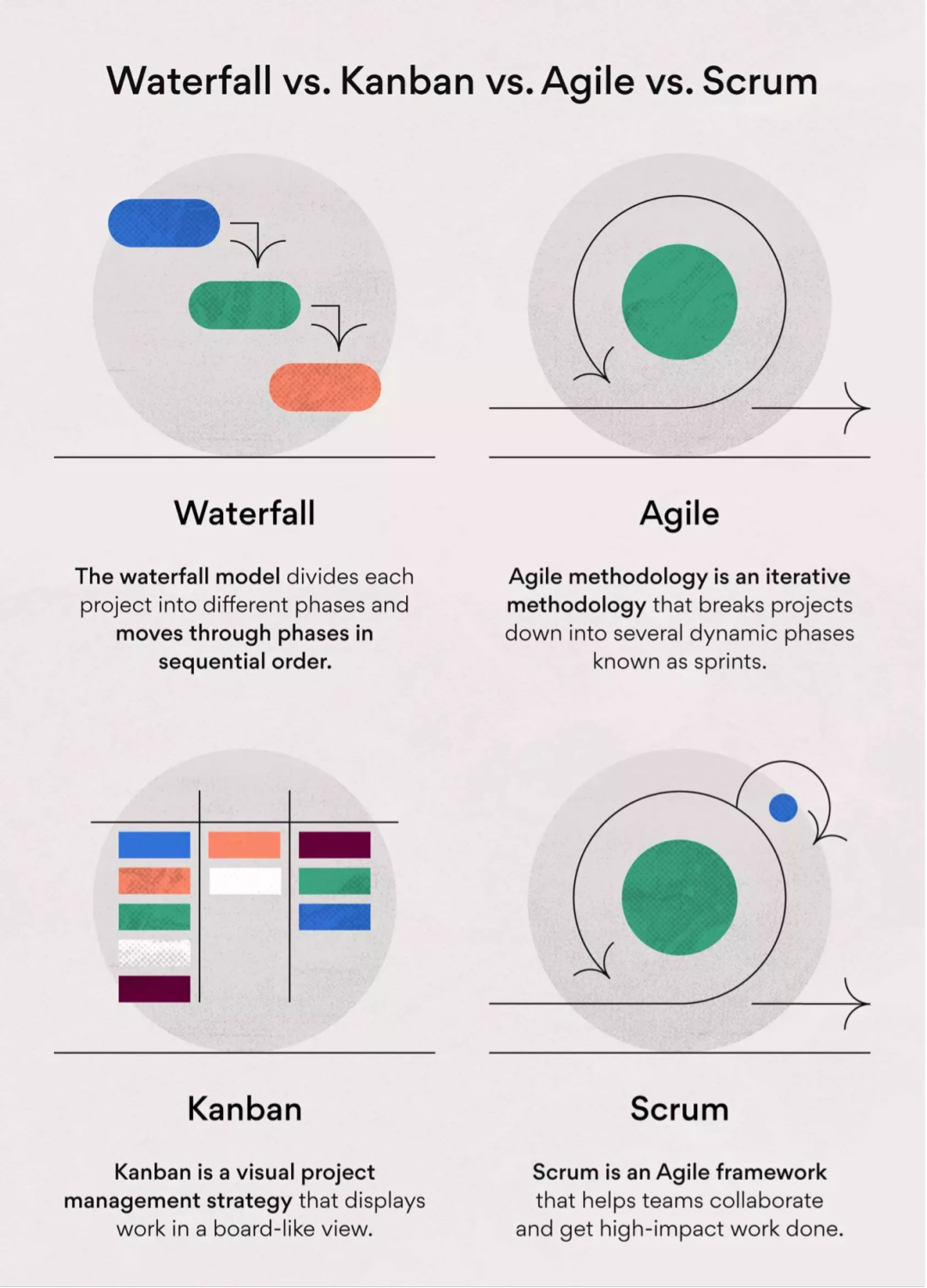
When to use the Waterfall methodology
Use the waterfall methodology if…
- You’re working on a sequential project and no phase can begin unless the other is complete.
- You want to tightly control scope creep.
- You value clear, effective planning.
- You want to understand the entire development lifecycle before beginning the project.
- You value functionality over quick delivery.
When to use the Agile methodology
Try the Agile approach when…
- You want to use a more iterative process.
- You want to deliver results quickly—even if that means improving them later on.
- Your team moves quickly.
- Your team values adaptability over predictability.
- Your customers want to be active stakeholders.
When to use the Kanban methodology
A good way to decide if Kanban is right if…
- Your team needs a visual project management system.
- You want an at-a-glance way to understand where a project stands.
- You’re not on an engineering, product, or software development team.
- You run ongoing processes and projects.
- Most of your work isn’t produced in short periods of time.
When to use the Scrum methodology
Though not every team thrives on Scrum, yet might benefit from Scrum if…
- You’re on an engineering, product, software development, or Agile-based team.
- You think your team could benefit from a slightly more rigid structure.
- You have a large backlog of work to get through.
- Your team is motivated by quick deadlines and deliverables.
- Someone on your team is committed to being the Scrum master.
How to combine Scrum and Kanban
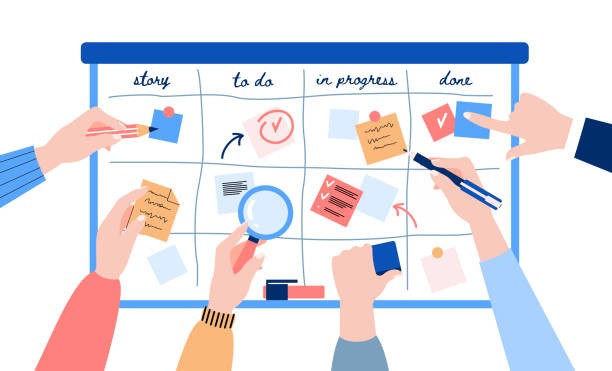
In order to host effective daily standup meetings, stellar sprint planning, and retrospectives, need a strong way to visualize work through stages and track all of the work in progress. Kanban boards can help to tackle sprint backlog and organize the flow of work during a sprint, so every Scrum cycle is a success.
Teams that run Scrum on Kanban boards frequently create a new board for every Scrum sprint. The reason for this is twofold:
- Teams that create new boards for every sprint can start with a clean slate. This makes it easier for the Scrum master and Scrum team to visualize the new work they have to do for each sprint.
- Scrum masters use past Scrum boards to track what work was accomplished during each Scrum cycle. Since a big reason teams implement Scrum is process improvement and efficiency, it can be helpful to look back and see what you’ve accomplished.
